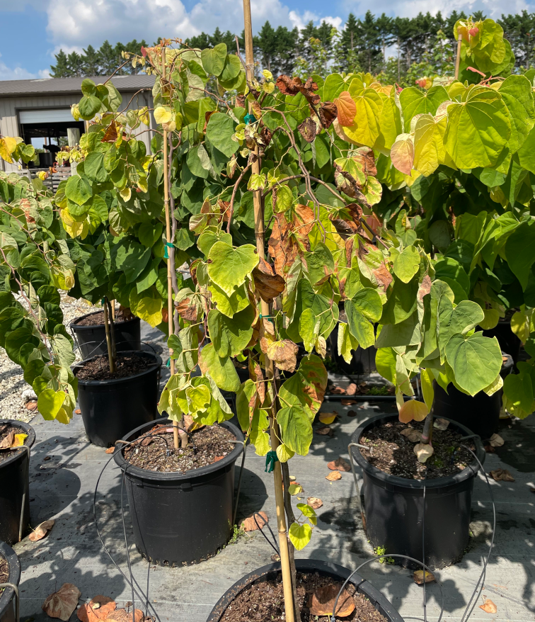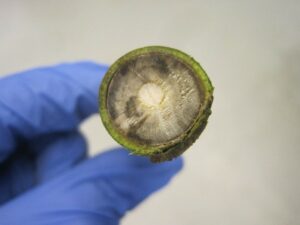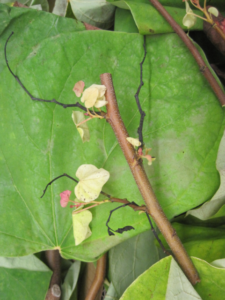Vascular Streak Dieback: A Disease of Ornamentals in the United States
go.ncsu.edu/readext?1044626
en Español / em Português
El inglés es el idioma de control de esta página. En la medida en que haya algún conflicto entre la traducción al inglés y la traducción, el inglés prevalece.
Al hacer clic en el enlace de traducción se activa un servicio de traducción gratuito para convertir la página al español. Al igual que con cualquier traducción por Internet, la conversión no es sensible al contexto y puede que no traduzca el texto en su significado original. NC State Extension no garantiza la exactitud del texto traducido. Por favor, tenga en cuenta que algunas aplicaciones y/o servicios pueden no funcionar como se espera cuando se traducen.
Português
Inglês é o idioma de controle desta página. Na medida que haja algum conflito entre o texto original em Inglês e a tradução, o Inglês prevalece.
Ao clicar no link de tradução, um serviço gratuito de tradução será ativado para converter a página para o Português. Como em qualquer tradução pela internet, a conversão não é sensivel ao contexto e pode não ocorrer a tradução para o significado orginal. O serviço de Extensão da Carolina do Norte (NC State Extension) não garante a exatidão do texto traduzido. Por favor, observe que algumas funções ou serviços podem não funcionar como esperado após a tradução.
English
English is the controlling language of this page. To the extent there is any conflict between the English text and the translation, English controls.
Clicking on the translation link activates a free translation service to convert the page to Spanish. As with any Internet translation, the conversion is not context-sensitive and may not translate the text to its original meaning. NC State Extension does not guarantee the accuracy of the translated text. Please note that some applications and/or services may not function as expected when translated.
Collapse ▲Sofia Pinzi, Center for Integrated Pest Management
Pest Description
Vascular streak dieback (VSD) poses a significant threat to nurseries cultivating eastern redbud (Cercis canadensis) and other woody ornamental plants.
The exact causal agent of VSD has not been definitively confirmed, but a fungus in the genus Ceratobasidium has been consistently associated with plants showing VSD symptoms. Since the exact species is still undetermined it is referred to as “Ceratobasidium sp.”.
Ceratobasidium sp. is closely related to Ceratobasidium theobromae, the pathogen associated with VSD in cacao in Asia. Work is ongoing to verify pathogenicity of Ceratobasidium sp. and its role in VSD. Ceratobasidium sp., like Ceratobasidium theobromae, is difficult to isolate, grow, and maintain in culture; this presents challenges for routine diagnosis, obtaining fungal material for DNA analysis, pathogenicity testing, and other research studies.
Epidemiology and Dispersal
The epidemiology of VSD is still poorly understood. The disease can be introduced and dispersed through the purchase of infected plants (possibly liners, rootstocks, and grafted material) that do not yet display symptoms. The current hypothesis is that Ceratobasidium sp. colonizes leaves via airborne basidiospores, spreads within the stems and branches, traveling through the vascular system. It is unclear under what conditions basidiospores are being produced and released, however, they have been detected via spore trapping and real-time PCR testing (F. Baysal-Gurel, personal communication, 2024).
Sporulation and spore dispersal of Ceratobasidium sp. are likely favored by high humidity. There is no evidence currently to suggest that the fungus spreads through seed.
Symptoms
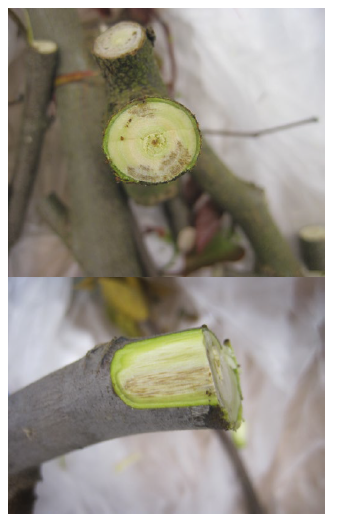
Figure 2. Dark streaking in the xylem of stems with green cambium in redbud. Images courtesy of NC State PDIC.
VSD affects both seedlings and mature plants, with symptoms that generally progress in the following order: stunting, interveinal chlorosis, marginal leaf scorching or browning, wilting and necrosis, and finally dieback (Fig. 1). In addition to these, plants may exhibit poor root development and stunted growth. The severity and pattern of symptoms can vary depending on the host, the mode of infection, and the time since infection occurred. Symptoms can be systemic and may be present across the entire plant or be confined to individual branches. The most diagnostic symptom of VSD is dark streaking in the water-conducting tissue (xylem) of affected branches and stems that still have green cambium (Fig. 2). In cut branches, the discoloration may appear as circular dots, rings, or a distinct marbled pattern (Fig. 3). In severe infections, individual streaks may merge, forming bands of discolored vascular tissue.
Occasionally, redbuds display “mouse ear leaves”— smaller than normal leaves that are light yellow or red in color (Fig. 4). The plant may also flower out of season. Dieback or leaf loss can occur on the main stem or individual side branches. Tip dieback may progress down the stem, leading to severe defoliation and potentially plant death.
Severely infected saplings may appear dead within months of transplanting into fields, but new shoot growth, typically from the base (epicormic shoots), may emerge later in the season.
Look-alike
Foliar symptoms of VSD, such as marginal scorch (Fig. 1), can be confused with those of bacterial leaf scorch, although the latter lacks vascular discoloration. VSD symptoms could also be mistaken for drought stress on landscape plants, which can produce similar signs. Additionally, VSD might be confused with other diseases like Verticillium wilt, laurel wilt, or fungal cankers, which all cause discoloration in the wood. Canker causing fungi, like Botryosphaeria, Phomopsis, and Cytospora, are frequently found on the same plants with VSD, so determining a plant has VSD without lab testing is extremely difficult.
Distribution
The Ceratobasidium sp. associated with VSD was first identified in North Carolina in 2019 and in 2020 from Tennessee, although it is believed that the disease was already present in the US previously. Since then, VSD has been reported from nurseries and landscape sites in several other states, including Alabama, Florida, Indiana, Maryland, Missouri, Oklahoma, Oregon, Pennsylvania, South Carolina, and Virginia.
Hosts
VSD can affect seedlings, grafted plants, older nursery stocks, and planted and natural landscape plants. The most commonly affected hosts are Eastern redbud, flowering dogwood, and maple, but it has been detected in more than 25 other genera (See Table 1).
| Family | Scientific Name | Common Name |
| Aceraceae | Acer griseum (Franch.) Pax | Paper bark maple |
| Acer rubrum L. | Red maple | |
| Acer × freemanii A.E. Murray [rubrum × saccharinum] | Freeman maple | |
| Acer saccharum Marsh. | Sugar maple | |
| Altingiaceae | Liquidambar styraciflua L. | Sweetgum |
| Anacardiaceae | Rhus aromatica Aiton | Aromatic sumac |
| Cotinus coggygria Scop. | Smoketree | |
| Aquifoliaceae | Ilex glabra (L.) A. Gray | Inkberry |
| Bignoniaceae | Catalpa speciosa (Warder) Warder ex Engelm. | Northern catalpa |
| Catalpa bignonioides Walter | Southern catalpa | |
| Betulaceae | Betula nigra L. | River birch |
| Carpinus americana Michx. | American hornbeam | |
| Carpinus betulus L. | European hornbeam | |
| Caprifoliaceae | Abelia x grandiflora (Rovelli ex André) Rehder | Glossy abelia |
| Calycanthaceae | Calycanthus floridus L. | Sweetshrub |
| Cannabaceae | Celtis occidentalis L. | American hackberry |
| Cornaceae | Cornus florida L. | Flowering dogwood |
| Cornus kousa Hance | Kousa dogwood | |
| Cornus sericea L. | Red-osier dogwood | |
| Cupressaceae | Juniperus chinensis L. | Chinese juniper |
| Ericaceae | Rhododendron spp. | Rhododendron |
| Oxydendrum arboreum (L.) DC. | Sorreltree | |
| Fabaceae | Albizia julibrissin Durazz. | Mimosa-tree |
| Cercis canadensis L. | Eastern redbud | |
| Cladrastis kentukea (Dum. Cours.) Rudd | Yellowwood | |
| Fagaceae | Quercus palustris L. | Oak |
| Quercus rubra L. | Northern red oak | |
| Quercus shumardii Buckley | Shumard oak | |
| Ginkgoaceae | Ginkgo biloba L. | Ginkgo |
| Hamamelidaceae | Fothergilla spp. L. | Witch alder |
| Hamamelis x intermedia ‘Arnold’s Promise’ | Witch hazel | |
| Hamamelis virginiana L. | Witch hazel | |
| Hydrangeaceae | Hydrangea arborescens L. | Hydrangea |
| Juglandaceae | Carya glabra (Mill.) Sweet | Pignut hickory |
| Lauraceae | Lindera benzoin Thunb. | Spicebush |
| Sassafras albidum (Nutt.) Nees | Sassafras | |
| Lythraceae | Lagerstroemia indica L. | Crape myrtle |
| Lagerstroemia spp. ‘Cherry Dazzle’ | Crape myrtle | |
| Magnoliaceae | Liriodendron tulipifera L. | Tulip poplar |
| Magnolia ashei Weath. | Ashe’s magnolia | |
| Magnolia grandiflora L. | Southern magnolia | |
| Magnolia tripetala (L.) L. | Umbrella magnolia | |
| Magnolia virginiana L. | Sweetbay magnolia | |
| Myricaceae | Myrica cerifera (L.) Small | Wax myrtle |
| Myrica pensylvanica Mirb. | Bayberry | |
| Nyssaceae | Nyssa sylvatica Marshall | Blackgum |
| Oleaceae | Osmanthus x ‘Fortunei’ | Osmanthus |
| Osmanthus heterophyllus ‘Gulftide’ | Osmanthus | |
| Syringa pubescens Turcz. subsp. patula (Palib.) M. C. Chang & X. L. Chen | ||
| Syringa reticulata (Blume) H. Hara | Giant tree lilac | |
| Platanaceae | Platanus x acerifolia L. | Planetree |
| Rosaceae | Amelanchier canadensis (L.) Medik. | Serviceberry |
| Amelanchier laevis Wiegand | Allegheny serviceberry | |
| Crataegus viridis L. | Green hawthorn | |
| Prunus americana Marshall | American plum | |
| Prunus persica (L.) Batsch | Peach | |
| Prunus salicina Lindl. | Japanese plum | |
| Prunus × yedoensis Matsum. | Yoshino cherry | |
| Spiraea japonica L. | Japanese spiraea | |
| Salicaceae | Salix L. | Willow |
| Salix gracilistyla ‘Melanostachys‘ | Japanese willow | |
| Sapindaceae | Aesculus sylvatica W. Bartram | Painted buckeye |
| Styracaceae | Styrax japonicus Siebold & Zucc. | Japanese snowbell |
| Taxodiaceae | Taxodium distichum (L.) Rich. | Bald cypress |
| Tiliaceae | Tilia americana L. | Basswood |
| Ulmaceae | Ulmus parvifolia Jacq. | Chinese elm |
| Viburnaceae | Viburnum macrocephalum Fortune | Chinese snowball |
| Viburnum opulus L. | Guelder-rose |
Pest Management
Chemical, Cultural and Mechanical Control
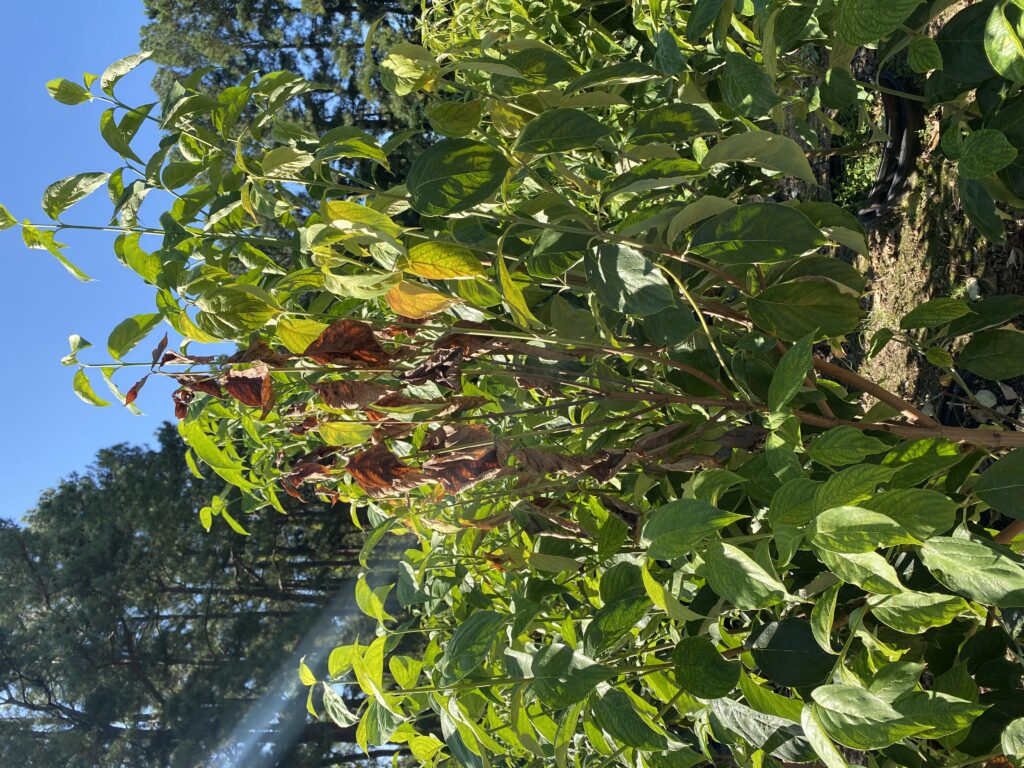
Figure 5. VSD in Cornus florida L. (Flowering dogwood). Image courtesy of Devin Bily, Virginia Department of Agriculture and Consumer Services
Currently, there are no chemical treatments specifically available for VSD. However, fungicide trials for VSD management in redbud production have shown that preventative foliar applications can help manage disease symptoms. The most effective treatments for suppressing leaf scorch associated with VSD in seedlings, three-year-old plants, and two-year-old grafted cultivars were:
- Postiva [pydiflumetofen (FRAC 7) + difenoconazole (FRAC 3)] at 20 fl oz/100 gal.
- Mural [azoxystrobin (FRAC 11) + benzovindiflupyr (FRAC 7)] at 7 oz/100 gal, both applied at 14-day intervals.
In addition to reducing leaf scorch, these treatments also lowered the population levels of canker-causing pathogens such as Botryosphaeria spp. and Didymella spp. However, while these treatments were effective in reducing symptoms associated with VSD, they did not cure plants that were already infected.
Soilborne pathogens such as Phytophthora, Pythium, Rhizoctonia, and Fusarium species have frequently been isolated from plants showing symptoms of VSD. Managing them may reduce the damage of VSD.
Some recommended fungicide rotations include:
- Empress or Heritage (FRAC 11), rotated with Medallion (FRAC 12) or Terraguard (FRAC 3)
- Mural or Orkestra (both FRAC 7+11), rotated with Terraguard (FRAC 3) or Medallion (FRAC 12)
General management practices include avoiding unnecessary pruning, using healthy plants for propagation, and ensuring proper irrigation and planting depth. It is important to keep stock purchased from different vendors separate, scouting for symptoms, and removal of symptomatic stock. When pruning, it is recommended to avoid excessive wounding by focusing on fewer, larger branches to improve airflow and light penetration in the canopy. Pruning should be performed in late winter or early spring, as summer conditions can create infection courts for canker pathogens, while fall injuries result in the longest-lasting decay. It is strongly recommended to remove cuttings from the nursery block and burn them to reduce the chance of spore dispersal.
It is also important to minimize herbicide injury, apply proper fertilization, and conduct regular scouting for early disease detection.
Resistant Cultivars
Preliminary trials conducted in Tennessee in 2022 have shown that redbud cultivars with yellow-colored foliage and waxy leaf texture were more susceptible to VSD than cultivars with dark green and purple foliage and thick glossy leaves. Unfortunately, none of the tested cultivars exhibited complete resistance to VSD. However, Cercis chinensis demonstrated tolerance, consistent with earlier observations in production nurseries.
Dr. Hsuan Chen, Assistant Professor in the Department of Horticultural Science at North Carolina State University, is currently working to develop interspecific hybrids to introgress resistant genes from Cercis chinensis into Cercis canadensis. In addition, Dr. Chen is exploring additional germplasm from other Cercis species to identify more potential sources of resistance.
Diagnostic Laboratories
In North Carolina growers can contact their N.C. Cooperative Extension Area Specialized Agent for commercial ornamental greenhouse and nursery crops to help diagnose this problem.
| Danny Lauderdale – Eastern Region |
| Stacey Jones – Central Region |
| Sam Marshall – Western Region |
Growers can also contact the N.C. Department of Agriculture and Consumer Services’ regional plant pest specialist, who can visit the facility and collect samples for analysis.
In North Carolina, growers can also submit plant material to the Plant Disease and Insect Clinic, operated by the NC State University Department of Entomology and Plant Pathology. Visit the National Plant Disease Diagnostic Network for laboratories outside of North Carolina.
In North Carolina, growers can also submit plant material to the Plant Disease and Insect Clinic, operated by the NC State University Department of Entomology and Plant Pathology.
How to collect and prepare samples for VSD diagnosis
Proper sampling is critical for diagnosing vascular streak dieback accurately. The following protocol outlines the steps for collecting appropriate samples from symptomatic trees or shrubs. When collecting samples, it’s important to choose plants that show clear symptoms of disease, such as dieback, wilting, or leaf discoloration. Follow the guidelines below for how to collect, handle, and ship samples to the appropriate diagnostic lab.
1) Find a live tree with individual branches that show dieback, wilting, scorched leaf margins, or mouse-eared new growth.
2) For liners or containers up to 1 gal, send several whole plants.
3) For larger trees or shrubs, collect samples from one or two symptomatic plants. Include all four of the following:
- Small-diameter stem subsample: Cut several stems at whichever of the
following is lower: the transition zone to healthy-looking foliage or wood, or the point at which the stem diameter reaches 1/2″. - Large-diameter subsamples: Cut 2 sections of the main stem, each about 8″ long.
– One section should start just below the graft union or at the soil line.
– The other section should be taken about halfway up the trunk. - Large root subsample: several short sections of the largest-diameter roots
- Fine root subsample (to rule out other problems): a fistful of feeder roots in
about a quart of soil. Keep roots in soil.
4) Immediately place all subsamples in plastic bags. Label all bags with the species, cultivar, location, and sampling date.
5) Do not allow the material to dry out, but do not add water or wet paper towels. Do not expose to heat or direct sun. Keep at room temperature or in the refrigerator if it cannot be sent or brought immediately to a diagnostic clinic. Do not pack on ice.
6) Pack all material in a sturdy cardboard box for shipping.
7) Follow your chosen laboratory’s procedures regarding submission forms and shipping.
For more information about VSD, watch our video series! In these short videos, experts share valuable insights on VSD, including its symptoms, management strategies, and resistant cultivars.
Video #1- What is VSD, hosts and management strategies, Dr. John Bonkowski, Plant and Pest Diagnostic Laboratory Diagnostician, Purdue University, Indiana
Video #2- VSD symptoms, Michael Munster, Plant Disease Diagnostician for commercial Ornamentals at the Plant Disease and Insect Clinic at North Carolina State University
Video #3- Resistant cultivars to VSD, Dr. Hsuan Chen, Assistant Professor in the Horticultural Science Department at North Carolina State University
Video #4 – VSD in North Carolina and how to submit plant samples, Stacey Jones, Area Specialized Agent, Commercial Nursery and Greenhouse, North Carolina State University
Grant coordinated by Dr. Godshen Robert, Dr. Roger Magarey, Dr. Yu Takeuchi, and Dr. Danesha Seth Carley.
Special thanks to the following experts for their contributions and insights on VSD: Michael Munster, Dr. Hsuan Chen, Stacey Jones, Devin Bily, Dr. John Bonkowski, and Dr. Fulya Baysal-Gurel for their help on this article
Acknowledgment
This work is supported by the Agriculture and Food Research Initiative Competitive Grants Program, Foundational and Applied Science Program, of the U.S. Department of Agriculture, National Institute of Food and Agriculture (NIFA), under grant/award number 2023-67013-41396.



